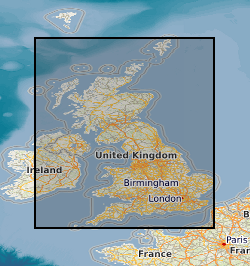Comma-Separated Values (CSV) file (.csv)
Type of resources
Available actions
Topics
Keywords
Contact for the resource
Provided by
Years
Formats
Representation types
Update frequencies
Scale
-

The concentrations of up to 30 trace elements in approximately 9,000 sea-bed samples from the UK Continental Shelf were determined by BGS using a variety of analytical techniques. In some cases samples were tested using more than one method. The analyses were carried out on freeze-dried samples of the sand and mud fractions of the samples. The data are stored as part of the National Geoscience Data Centre (NGDC) and the Marine Environmental Data and Information Network (MEDIN) Data Archive Centre (DAC) for Geology and Geophysics. Data are delivered via the BGS Offshore GeoIndex www.bgs.ac.uk/GeoIndex/offshore.htm geochemical layers. References: Stevenson, A G (2001) Metal concentrations in marine sediments around Scotland: a baseline for environmental studies, Elsevier Science; Stevenson, A G et al (1995) The geochemistry of sea-bed sediments of the United Kingdom Continental Shelf : the North Sea, Hebrides and West Shetland shelves, and the Malin-Hebrides sea area (http://nora.nerc.ac.uk/507899/).
-

This data contains raw electrical resistivity tomography (ERT) measurements made at the UKGEOS (United Kingdom Geoenergy Observatories) site at Thornton science park in Cheshire, as well as associated metadata, during February 2025. The measurements in this case were made in support of a 3-day closed loop heat injection test starting on the 10th of February 2025. During the test approx. 24kW of heat was equally distributed between 4 observatory heat exchanger boreholes via a circulating heat exchange fluid. This resulted in the fluid delivery temperature increasing from 12 to 27C. The ERT data was collected from 12 boreholes instrumented with ERT electrodes at 1m intervals from 12 to 96 m below the ground surface to facilitate down and cross- hole imaging with electrical currents (1008 electrodes in total). The electrodes are connected to a geoelectrical monitoring system comprising two PRIME servers (1 and 2) which are installed at the site indefinitely. The PRIME instrument is bespoke developed by the British Geological Survey (BGS) for long term geoelectrical monitoring applications, in this case the purpose of the data is to study how the electrical resistivity of the ground responds to temperature changes and other hydrogeological processes. Metadata includes the position of the electrodes within the subsurface, furthermore, finite element meshes are included to aid the user in processing this data. There is a readme (text) file provided with this data that describes its formatting and usage. This data is managed by BGS.
-

The British Geological Survey Geophysical Logs Database provides an index into downhole geophysical log data from onshore UK boreholes held by BGS within the National Geoscience Data Centre (NGDC). Geophysical log data may be used to understand stratigraphy, aid mapping work, assess resources like groundwater and quantify subsurface variability, so they are critical to many projects across the geoscience sector in the UK, including those which contribute towards net zero objectives such as the assessment of geothermal resources, storage of heat and waste materials, and the identification of mineral resources. The database includes hardcopy records (with digital scans) as well as digital wireline data in lis, las and dlis format. The data are linked to the Single Onshore Borehole Index and may be queried by borehole and spatial location. Hardcopy records are held in NGDC at BGS Keyworth. Some of the digital wireline data are in binary file formats, including .lis, .dlis, .tap and .tif (not an image format), which require specialist logging software to use. The database represents the combination of three historic databases which date from 1985 onwards, and the primary data were collected by different drilling companies and for different purposes, so the data have varying provenance and therefore quality. Not all data in the database are provided externally. Some data remain confidential, and because of the aggregate nature of the dataset, a small amount of the data are considered suspect and are not provided publicly. Significant collections within the database are: 1. Data acquired by the former National Coal Board and British Coal during their exploration for coal in the UK. Ownership of UK coal exploration data was transferred to the Coal Authority (now the Mining Remediation Authority) following privatisation of the UK coal industry, with British Geological Survey as custodian of the data. These data are in general publicly available; however, access to data within active mining licences is restricted in that it requires the consent of the mining licensee. The Coal Authority data archive includes digital data for some of the geophysical borehole logging. These are mainly in the form of original field tapes; however, also available are some data transcribed onto more modern media during BGS projects. 2. Data from onshore hydrocarbon wells regulated by the North Sea Transition Authority (NSTA; formerly known as DECC – Department of Energy and Climate Change and OGA – Oil and Gas Authority). These oil and gas wells deeply penetrate the crust (often over 1 km deep) under the UK mainland and are geographically widespread.
-

The BGS Geophysical Logs Database contains downhole geophysical log data from onshore UK boreholes drilled for the purpose of oil and gas exploration and extraction. These wells are regulated by the North Sea Transition Authority (NSTA; formerly known as DECC – Department of Energy and Climate Change and OGA – Oil and Gas Authority) and deeply penetrate the crust (often over 1 km deep) under the UK mainland, making the data collected from them useful for a variety of purposes. This dataset is a subset of the BGS Geophysical Logs Database.
 NERC Data Catalogue Service
NERC Data Catalogue Service